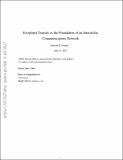Exoplanet transits as the foundation of an interstellar communications network
Abstract
Two fundamental problems for extraterrestrial intelligences (ETIs) attempting to establish interstellar communication are timing and energy consumption. Humanity's study of exoplanets via their transit across the host star highlights a means of solving both problems. An ETI ‘A’ can communicate with ETI ‘B’ if B is observing transiting planets in A's star system, either by building structures to produce artificial transits observable by B, or by emitting signals at B during transit, at significantly lower energy consumption than typical electromagnetic transmission schemes. This can produce a network of interconnected civilizations, establishing contact via observing each other's transits. Assuming that civilizations reside in a Galactic Habitable Zone (GHZ), I conduct Monte Carlo Realization simulations of the establishment and growth of this network, and analyse its properties in the context of graph theory. I find that at any instant, only a few civilizations are correctly aligned to communicate via transits. However, we should expect the true network to be cumulative, where a ‘handshake’ connection at any time guarantees connection in the future via e.g. electromagnetic signals. In all our simulations, the cumulative network connects all civilizations together in a complete network. If civilizations share knowledge of their network connections, the network can be fully complete on timescales of order a hundred thousand years. Once established, this network can connect any two civilizations either directly, or via intermediate civilizations, with a path much less than the dimensions of the GHZ.
Citation
Forgan , D H 2018 , ' Exoplanet transits as the foundation of an interstellar communications network ' , International Journal of Astrobiology , vol. First View . https://doi.org/10.1017/S1473550417000283
Publication
International Journal of Astrobiology
Status
Peer reviewed
ISSN
1473-5504Type
Journal article
Rights
© Cambridge University Press 2018. This work has been made available online in accordance with the publisher’s policies. This is the author created, accepted version manuscript following peer review and may differ slightly from the final published version. The final published version of this work is available at https://doi.org/10.1017/S1473550417000283
Description
The author gratefully acknowledges support from the ECOGAL project, grant agreement 291227, funded by the European Research Council under ERC-2011-ADG, and the STFC grant ST/J001422/1.Items in the St Andrews Research Repository are protected by copyright, with all rights reserved, unless otherwise indicated.

